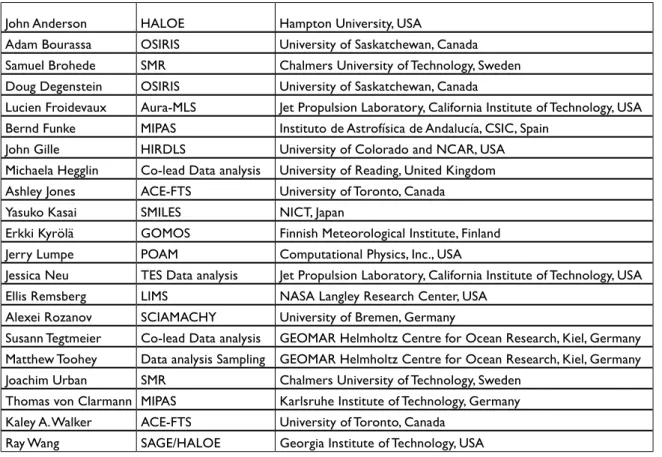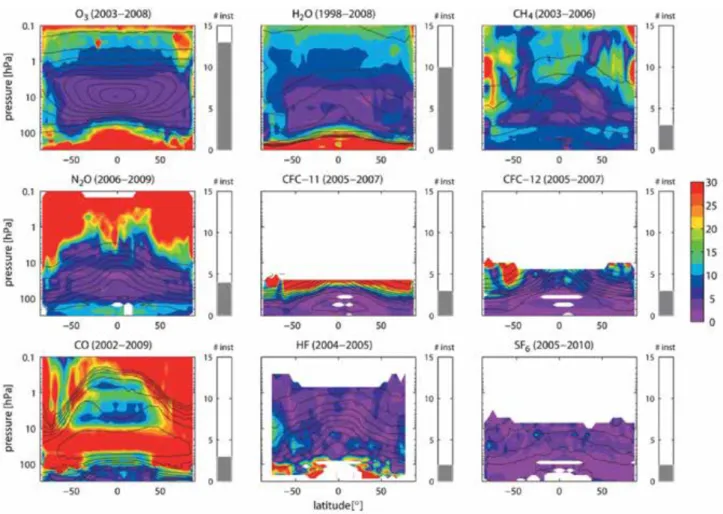7
SPARC newsletter n° 49 - July 2017
www.sparc-climate.org
The SPARC Data Initiative – Results of a long journey
Susann Tegtmeier1 and Michaela Hegglin2
1GEOMAR, Helmholtz Centre for Ocean Research Kiel Germany, (stegtmeier@geomar.de), 2University of Reading, Reading, UK, (m.i.hegglin@reading.ac.uk).
A new SPARC report providing an assessment of the availability and quality of stratospheric satellite trace gas observations was published in March 2017 (available at www.sparc-climate.org/publications/
sparc-reports). This assessment was compiled by the SPARC Data Initiative team and includes the most up-to-date and comprehensive comparison of stratospheric constituent observations. The report provides knowledge and guidance to data users and chemistry-climate modellers, as well as feedback to instrument teams and space agencies about required improvements in existing datasets and the need for future observations.
The SPARC Data Initiative was started in 2009 by the co-leads Michaela Hegglin and Susann Tegtmeier and was endorsed as a SPARC activity the following year. The two co-leads brought
together an international team of data analysts and instrument experts representing the most important limb sounders from the CSA, ESA, JAXA, NASA, SNSB, and other national space agencies (Table 1). The SPARC Data Initiative team has worked together over the last seven years to fulfill three major objectives:
1. Assessing the state of data availability from the multi-national suite of space-based instruments;
2. Compiling climatologies of chemical trace gases and making them available through the SPARC Data Centre;
3. Providing a detailed intercomparison of the trace gas climatologies.
During its first phase in 2010-2011, the SPARC Data Initiative successfully applied as an international team
John Anderson HALOE Hampton University, USA
Adam Bourassa OSIRIS University of Saskatchewan, Canada Samuel Brohede SMR Chalmers University of Technology, Sweden Doug Degenstein OSIRIS University of Saskatchewan, Canada
Lucien Froidevaux Aura-MLS Jet Propulsion Laboratory, California Institute of Technology, USA Bernd Funke MIPAS Instituto de Astrofísica de Andalucía, CSIC, Spain
John Gille HIRDLS University of Colorado and NCAR, USA
Michaela Hegglin Co-lead Data analysis University of Reading, United Kingdom Ashley Jones ACE-FTS University of Toronto, Canada
Yasuko Kasai SMILES NICT, Japan
Erkki Kyrölä GOMOS Finnish Meteorological Institute, Finland
Jerry Lumpe POAM Computational Physics, Inc., USA
Jessica Neu TES Data analysis Jet Propulsion Laboratory, California Institute of Technology, USA
Ellis Remsberg LIMS NASA Langley Research Center, USA
Alexei Rozanov SCIAMACHY University of Bremen, Germany
Susann Tegtmeier Co-lead Data analysis GEOMAR Helmholtz Centre for Ocean Research, Kiel, Germany Matthew Toohey Data analysis Sampling GEOMAR Helmholtz Centre for Ocean Research, Kiel, Germany Joachim Urban SMR Chalmers University of Technology, Sweden
Thomas von Clarmann MIPAS Karlsruhe Institute of Technology, Germany Kaley A. Walker ACE-FTS University of Toronto, Canada
Ray Wang SAGE/HALOE Georgia Institute of Technology, USA
Table 1: SPARC Data Initiative team including information on the role within the team (instrument represented or data analysis) and affiliation.
8
SPARC newsletter n° 49 - July 2017
www.sparc-climate.org
activity to the International Space Science Institute (ISSI) in Bern, Switzerland. Two week-long workshops at the ISSI allowed for intensive and productive discussions on the advantages and drawbacks of the climatological evaluation approach of the SPARC Data Initiative. Bringing together data analysts and different instrument teams helped to explore many relevant questions such as the influence of a priori on climatologies, the impact of interpolation in altitude, and the terminology and ambiguousness of error terms. Some topics such as the impact of instrument sampling patterns, of averaging kernels, and averaging techniques were further investigated as part of the Data Initiative activities. Based on the expertise of the team, valuable information on general topics such as satellite orbits, observation geometries and measurement techniques, and specific descriptions of the participating instruments and retrieval versions were collected. During this phase, all chemical trace gas and aerosol monthly zonal-mean time series were also compiled in a common and simple-to-use NetCDF data format.
Overall, the strong support and combined efforts of the SPARC Data Initiative team allowed fast progress of the activity within its first phase.
During its second phase in 2012-2013, the SPARC Date Initiative carried out detailed comparisons of ozone (Tegtmeier et al., 2013) and water vapour (Hegglin et al., 2013), as well as other longer-lived trace gases such as N2O, CH4, CO, SF6, HF, CFC- 11, CFC-12, HNO3, and NOy. The comparisons identified strengths and shortcomings of all datasets and differences between them. By evaluating monthly zonal-mean averages, the SPARC Data Initiative followed a new climatological approach to data validation with the advantages of being consistent for all instrument comparisons, avoiding sensitivities to chosen coincidence criteria, and generally producing larger sample sizes. The SPARC Data Initiative team developed an estimate of the uncertainty of the trace gas mean state derived from the inter-instrument spread of ±1σ. The uncertainty estimates are given as synopsis plots (see Figure 2
Figure 2: Synopsis of uncertainty in the annual zonal mean state of longer-lived species. The relative standard deviation over all instruments’
multi-annual zonal mean datasets is presented for O3, H2O, CH4, N2O, CFC-11, CFC-12, CO, HF, and SF6 (color contours). The black contour lines represent the multi-instrument mean trace gas distribution for each species. The number of instruments included is given by the right- hand grey bar.
9
SPARC newsletter n° 49 - July 2017
www.sparc-climate.org
for longer-lived gases) and helps to identify species and regions where further investigations or more data are needed.
The climatological approach has the disadvantage that monthly and annual zonal mean climatologies may be biased due to non-uniform sampling. This effect was investigated by estimating the impact of each instrument’s sampling patterns on ozone and water vapour climatologies yielding useful information for studies of variability and trends and for comparisons with free-running models (Toohey et al., 2013). Furthermore, the impact of averaging kernels in the upper troposphere/lower stratosphere region was investigated by smoothing observations of the higher vertical resolution limb sounders with the TES observational operator (Neu et al., 2014). The results of the overall comparisons were discussed and approved during review meetings in Toronto, Canada, and Granada, Spain, to which a sub-set of reviewers of the work were invited each time.
During its final phase in 2014-2016, the SPARC Data Initiative completed the evaluations of all short-lived species such as NO, NO2, NOx, HCl, ClO, BrO, CH2O, and aerosol. These comparisons werecomplicated by the strong diurnal cycles of these trace gases as well as wavelength dependencies of the aerosol extinction retrieval products. Different approaches for comparisons of the short-lived trace gases and the aerosol products are explored in the SPARC Data Initiative report resulting in uncertainty estimates of the shorter- lived nitrogen- und halogen-containing gases. Results of the comparisons have important implications for data analysis, trend evaluations, merging exercises, and model-measurement comparisons. With regard to the latter, the SPARC Data Initiative developed improved model evaluation diagnostics that are supported by a well-defined and small observational uncertainty.
All analyses, comparisons, and implications resulting from the SPARC Data Initiative have been published in the report making it the most up-to- date comprehensive assessment of stratospheric constituent observations. The report was produced with tremendous support from the SPARC offices in Toronto (Diane Pendlebury) and Zurich (Petra Bratfisch and Carolin Arndt), for which the SPARC Data Initiative Team is most grateful. We thank all contributing authors and reviewers for their continued support over the past years. We also thank WCRP and the different space agencies for their financial support for travel funding and in-kind support. One final word – this SPARC activity was a great experience that has formed the foundation for many strong collaborations. The SPARC Data Initiative report is dedicated to the memory of our friend and colleague Joachim Urban whose contribution and commitment were essential to this work.
References
Hegglin, M., et al., 2013: SPARC Data Initiative: Comparison of water vapor climatologies from international satellite limb sounders. J. Geophys. Res.-Atmos., 118, 11824-11846, doi:10.1002/
jgrd.50752
Neu, J., et al., 2014: The SPARC Data Initiative: Comparison of upper troposphere/lower stratosphere ozone climatologies from limb-viewing instruments and the nadir-viewing Tropospheric Emission Spectrometer. J. Geophys. Res.-Atmos., 119, 6971-6990, doi: 10.1002/2013JD020822.
Tegtmeier, S., et al., 2013: SPARC Data Initiative: A comparison of ozone climatologies from international satellite limb sounders. J. Geophys. Res. Atmos., 118, 12229–12247, doi:10.1002/2013JD019877.
Toohey, M., et al., 2013: Characterizing sampling biases in the trace gas climatologies of the SPARC Data Initiative. J. Geophys.
Res.-Atmos., 118, 11847– 11862, doi:10.1002/jgrd.50874.

